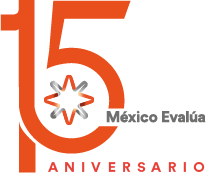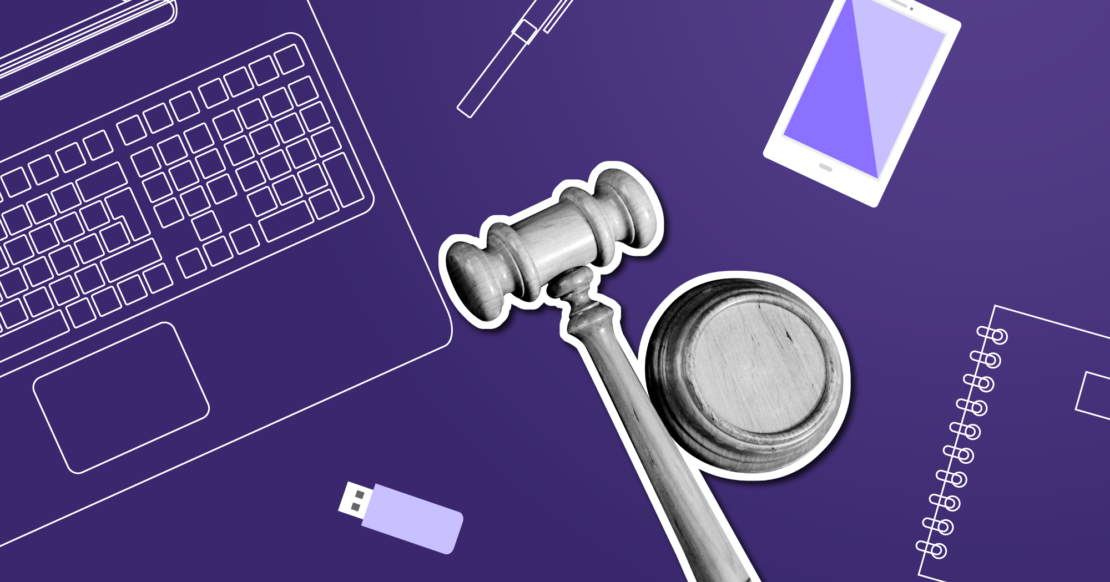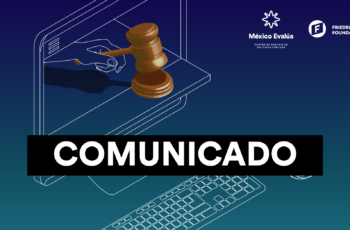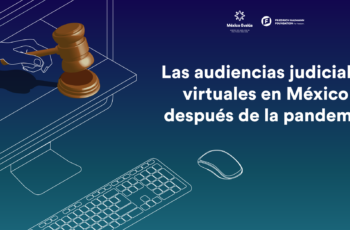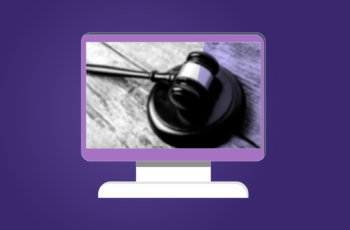Covid-19 and the possibilities of digital justice
By Laurence Pantin (@lpantin) | Proceso
In the context of the health emergency declared by the General Health Council, on March 31st, the Ministry of Health placed the administration of justice on the list of activities considered essential. However, no guidelines or simple instructions have been issued to precisely define which justice administration services are essential.
This lack of clarity, perhaps, explains the differentiated position taken by the judiciary. On March 17th, the federal Judiciary announced the suspension of its work and procedural deadlines and terms, with the exception of guards in some jurisdictional bodies for the attention of some considered urgent (in criminal and amparo matters). Most local judiciaries followed this general guideline, but many with their own suspension deadlines and adaptation process.
They have responded to the contingency in an “artisan way”, as Ana María Ramos, deputy director of the Corporation for Excellence in Justice of Colombia would say[1]. However, it is clear that some powers have more tools to respond to it than others, and these tools are technological. To learn about their particular challenges and crossroads, we reviewed the agreements reached by the different judicial powers and spoke with several court presidents, local judicial advisers and other judicial officials. This is how the picture looks.
New technologies allow judicial teleworking
From the outset, the judicial powers that have developed the electronic file have a clear advantage[2], because by allowing the litigants and the parties to consult the file and its notifications online, this tool makes it possible to avoid or limit the concentration of people in the courts, which is precisely an objective of the ‘healthy distance’ policy. But not only for that reason, this solution also allows jurisdictional officials to work from home[3]. Thus, some judicial powers are focused on reducing the workload or the backlog they had until now. For example, Judge José Antonio Ortega, president of the Superior Court of Justice and of the Judicial Council of Querétaro, estimates that his courts and chambers will return to activities with zero load. For his part, José Antonio León, president of the Judicial Branch of Quintana Roo, affirms that in his state the judges are waiting for the procedural deadlines to resume in order to publish all the draft sentences that they have been working from their homes during the contingency.
In other judicial powers, where there is no electronic or digitalized file, teleworking is much more complicated and carries a certain risk. In some cases, such as Campeche, staff who do not perform on-site duty have been asked to work from home, so in practice they are authorized to “extract duplicate documentation or files from the offices,” under the responsibility of the heads of the jurisdictional bodies.
An advantage regarding the electronic file are the virtual or electronic court systems, which allow not only the consultation of files, but also that the public ministries, public defenders and litigants present promotions and/or lawsuits online, avoiding, once more, having to go to court. These are a reality in the judicial powers of Aguascalientes, Baja California, State of Mexico, Nuevo León and Tamaulipas, but they entail a certain degree of complexity, since these services are accessed through an electronic signature. Obtaining this requires user authentication, which necessarily implies a face-to-face procedure. However, some judiciaries are looking at alternatives in order to encourage litigants not to appear in court and to use the electronic court. Thus, the Judicial Branch of the State of Mexico has enabled a temporary mechanism so that an electronic signature can be requested through a videoconference appointment.
For its part, on March 17th, the Judicial Branch of Nuevo León published an agreement that listed the measures against Covid-19, in which it established that in-person guards could only receive promotions on urgent matters. However, litigants have not stopped making promotions on non-urgent matters through the virtual court. It is partly for this reason that the judges want to advance in the draft agreements on non-urgent matters because they know that upon their return a very important workload will await them, according to the Counselor of the Judiciary José Antonio Gutiérrez Flores. However, in this judiciary, where the current system only allows filing motions in already open cases, the systems area is developing a mechanism so that new lawsuits can also be filed online.
Online hearings: A reality?
Requests for proceedings and notifications are another procedure that, predictably, can be streamlined through the use of new technologies. Thus, the judicial powers of Nuevo León and Querétaro are developing solutions to allow litigants to request online (or cancel) their proceedings.
On the other hand, in some judicial powers there are online courts. This is the case of the Specialized Control Court for Searches and Online Arrest Warrants of the Judicial Branch of the State of Mexico, which has existed since 2016 and operates 24 hours a day. It allows the Prosecutor’s Office to present its requests for arrest and search warrants from a computer and one of the judges on duty resolves and sends an answer online.
Another aspect that can be carried out remotely is the audience. As seen in the following table, as of April 14th, when we conducted this review exercise, 14 judicial branches had announced that they will use videoconferencing to conduct hearings. For example, in Nuevo León, since before the contingency, the public ministry and the accused could participate in hearings remotely. Now, this judiciary has developed a mechanism so that the public defender can also connect remotely, and is working in a way that the parties and private lawyers can also do so. The same happens in Tamaulipas, where the extensive geography and high-impact crimes have motivated the judiciary to develop an internal platform to carry out virtual hearings from two different places. But with the contingency, it has worked so that they can be carried out from more locations. And on Holy Thursday and Good Friday, the information technology department trained its officials and operators from the Prosecutor’s Office, the Public Defender’s Office and the Victim Assistance Commission so that they can use the tool, says Arnoldo Huerta Rincón, executive secretary of the Council of the Judiciary.
Judiciaries that have announced the use of videoconference hearings
| Judiciary | Date the use of videoconferencing for hearings was announced | Document where it is announced | Precision |
|---|---|---|---|
| Nuevo León | March 17th | Agreement | In criminal matters and justice for adolescents, it will be ensured that the intervention of the public ministry and the accused, when he is detained, is carried out by videoconference |
| Yucatán | March 23rd | Official Notice | A hearing was held on justice for adolescents |
| Aguascalientes | March 30th | Agreement | Hearings may be held by videoconference in criminal and family matters and will be held preferably through Zoom |
| San Luis Potosí | March 31st | Official Notice | Hearings may be held by videoconference in criminal matters |
| Mexico City | March 31st | Message from the President | The parties will intervene in the hearings from different rooms, using telepresence |
| Federal | April 2nd | Agreement of the Council of the Federal Judiciary | The judges of the Federal Criminal Justice Centers are authorized to use hearings by videoconference. It is specified that they could also be used for non-urgent matters in the event that the catalog of matters that the judges can resolve is expanded |
| Federal | April 10th | Message on Twitter from Minister Arturo Zaldívar | The Supreme Court of Justice of the Nation will begin to meet remotely from April 20th |
| Coahuila | April 6th | Agreement | Hearings may be held by videoconference in criminal matters. It is specified that they could also be used for non-urgent matters at the discretion of the judge |
| Oaxaca | April 6th | Agreement | Hearings may be held by videoconference in criminal matters. It could be by Zoom or Skype |
| Hidalgo | April 7th | Agreement | Hearings may be held by videoconference in criminal matters. It may be through technological platforms that are easily accessible to citizens |
| Michoacán | April 7th | Agreement | Hearings may be held by videoconference in criminal matters |
| Tamaulipas | April 8th | Agreement | Hearings may be held by videoconference in criminal matters and justice for adolescents. It is specified that they could also be used for non-urgent matters in the event that the catalog of matters that the judges can resolve is expanded |
| Baja California Sur | April 12th | Agreement | Hearings may be held by videoconference in criminal matters |
| Chiapas | April 12th | Agreement | A hearing was held on justice for adolescents |
| Guanajuato | April 14th | Official Notice | Hearings by videoconference in criminal matters should be prioritized |
Transparency and other challenges that technology poses
However, it is important to point out that the technological mechanisms to speed up the delivery of justice are not exempt from obstacles. To begin with, the topic of computer security can be a challenge. For example, with regard to holding virtual hearings, the use of existing platforms, such as Zoom, for example, whose lack of security has
been pointed out by the FBI since outsiders can interfere in a session, does not necessarily guarantee that the hearings are carried out properly. It is for this reason, in fact, that some judicial powers, such as in the State of Mexico, have developed internal videoconferencing systems that aim to offer sufficient levels of security to hold court hearings, explains Moisés Lima, head of the Information Technology Directorate of that judiciary. There, this system has existed for two years, but it has not yet been implemented, so now the final tests are being resumed to enable the tool.
Another obstacle to the greater use of technology in the delivery of justice is the unequal internet coverage in the country. No matter how much a judiciary strives to create first-rate programs or applications, if those who have to be involved in a trial do not have access to Internet or live in areas with poor reception, the tools cannot be used.
As for the hearings themselves, in criminal matters, they must guarantee immediacy –the presence of a judge– and respect for the fundamental rights of the accused, especially their right to an adequate defense and due process. For this reason, in most of the judicial powers where the use of videoconferences has been authorized, it is established that all the participants are duly identified and visible and that the accused and his defense attorney are in the same physical space – keeping distance measures. and hygiene recommended in this contingency – to be able to communicate privately at any time[4]. Additionally, it is pointed out that if the defendant’s health does not allow him to be in the same space as his defender, the judge will have to grant the necessary breaks so that both can talk in private. However, there is concern, not only in Mexico but also in other latitudes where hearings are beginning to be held in this way, as to whether this type of hearing really allows immediacy and the right to defense[5] . It is a question that can only be answered with experience.
It is important to point out that another challenge that has not yet been resolved with this type of procedure is that of transparency. Normally, hearings in criminal matters must be open to the public, which allows – at least on paper, because in practice hearings that have the public are an exception – that their development is subject to public scrutiny. Now, in order to preserve everyone’s health, the first measure that the judicial powers have taken has been to close the hearings to the public. In the guidelines for conducting hearings by videoconference, it has also been decided not to allow people outside the process to connect. The idea is that, if access to the hearings is left open, there is a danger of overexposing the accused. However, this prevents it from being a way to ensure that these hearings respect the rights indicated above. Making public versions of the video recordings could remedy this, but without a doubt the time this task requires adds complications. Another option could be that the public versions are made only based on the audio of the hearings.
Finally, another obstacle that some judicial powers may face when implementing technological solutions in this contingency is the existing regulations. The judicial powers that have been able to develop technological tools have long had local legislation that supports these changes. In other states, existing regulations may make it more difficult to use certain technologies.
An evolution of the administration of justice?
The obligatory question in the current circumstances is what is going to happen with the delivery of justice in the event that the contingency continues for longer. Many judicial powers are thinking about the possibility of expanding the catalog of matters that the judges must attend to. Thus, when they have authorized the use of videoconference hearings, some judicial powers, such as the federal and Tamaulipas, have specified that this authorization would also be applicable if the catalog of matters that they must hear is expanded. In fact, the Judicial Branch of Coahuila has already authorized
the judges to use this type of hearing to deal with non-urgent matters, if they “deem it essential to guarantee access to justice and other fundamental rights of the people.”
The question is how to determine which issues should be addressed as a priority. There, each judiciary can, based on the knowledge of the local circumstances and the statistics of the matters that they tend to deal with, define which ones may be most critical for the population of their state.
The answers will be tailor-made and, as we have said, ‘artisanal’, in the good sense of the word, because in the absence of similar precedents, the institutions have to adapt and be creative in order to offer the best possible service, preserving everyone’s health.
It is also necessary to see that not all the tasks of administering justice can be carried out from a distance. Although they may entail virtual modalities like the reception of lawsuits and promotions –in charge of the filing offices–, the reception and delivery of alimony –in charge of the consignment offices– and certain procedures –in charge of the notifiers and executors– some tasks often must be done physically.
Even though this contingency entails many tragic aspects, it can also represent an opportunity to think about mechanisms to improve access to justice, when things return to normal.
For example, as a result of the current contingency, the Judicial Branch of Querétaro is thinking of offering guidance to citizens online.
Of course, the judicial powers that are developing new technological tools to facilitate consulting the files status, submitting lawsuits and promotions, requesting proceedings or conducting hearings remotely, will have to ask themselves which of these can be maintained or adapted after the contingency.
This is important because they can allow not only a broader access to justice, but they can also generate savings in time and/or paper. In fact, they can also allow thinking about ways to make the work that judicial officials do more flexible, in particular those who have to take care of other people. But many of these tools could also help reduce the spaces for corruption that still exist when carrying out judicial procedures. This is, as long as its development includes the necessary security and locks and is accompanied by the corresponding transparency and accountability.
In fact, many of these tools had already been explored before the contingency, but had not necessarily been developed or implemented due to lack of resources or resistance from officials of the judiciary and/or lawyers.
But now that the contingency has slashed litigants’ incomes or threatens to double judicial officers’ workloads when they return to normal activities, they are often the first ones to greet technological advances that allow them to work from home, explained the judicial officials interviewed.
The road is not easy. As the counselor of the Nuevo León Judiciary, Gutiérrez Flores, points out, many doubts arise at this time, since measures are being undertaken that, in normal times, would not have been considered due to their complexity. “Seeing it from this perspective, we want to take extraordinary measures in the face of an extraordinary situation that we are experiencing, not only in the country but in the world. And these extraordinary measures lead us, perhaps if we were hesitant to do something, now to take the risk of doing it and see how we are coping as we go, for the benefit of the population of Nuevo León in this case.” His words are surely in line with the mood of many decision makers in the judiciary.
[1] This is how he referred to the response that the judicial powers in Latin America have had in the face of the pandemic, during a very interesting webinar organized on April 9th by a group of civil society organizations from Latin America and the United States led by Due Process of Law Foundation on the subject “Innovating in justice in times of emergency”.
[2] From what we could observe when reviewing the web pages of the judicial powers, this is the case of those of Aguascalientes, Baja California, Coahuila, State of Mexico, Nuevo León, Puebla, Querétaro, Quintana Roo, San Luis Potosí, Tamaulipas, Veracruz and Yucatán, at least in some subjects.
[3] It is important to point out here that teleworking represents an undeniable challenge for people who care for children, the elderly or people with different abilities. Although it is often thought that working from home allows you to carry out care tasks and work at the same time, they are often incompatible activities at the same time.
[4] This is the case in the Judicial Branch of Michoacán, for example, as stated in the April 7th agreement.
[5] This was a point of debate in the webinar organized on April 9th by a group of civil society organizations from Latin America and the United States led by the Due Process of Law Foundation on the subject “Innovating justice in times of emergency”, following a question from a person regarding criminal hearings in corruption cases that are being carried out by videoconferences in Ecuador.



